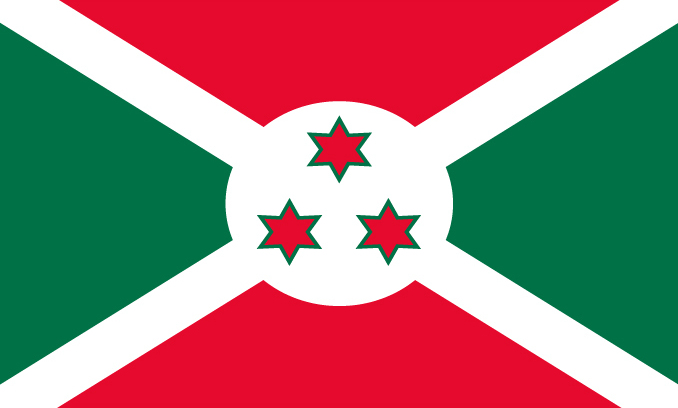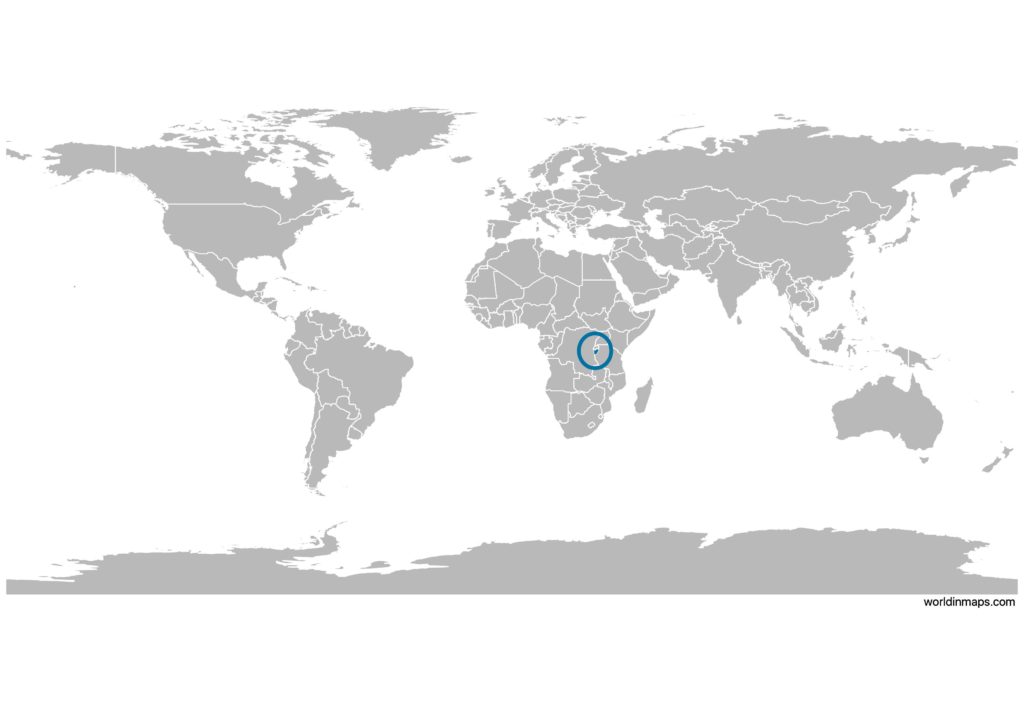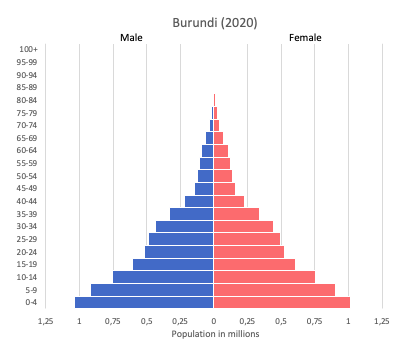Burundi

| Government | |
| Name | Republic of Burundi |
| Kirundi | Republika y’Uburundi |
| French | République du Burundi |
| Government type | Presidential republic |
| Capital (Political) | Gitega (41,944 (2008)) |
| Capital (Economic) | Bujumbura (497,166 (2008)) |
| Currency | Burundian franc (FBu) |
| People | |
| Population (2020) | 11,890,781 (84th) |
| Density of population | 401.6 P/km2 (20th) |
| Nationality | Burundian |
| Official languages | |
| Kirundi | |
| French | |
| English | |
| Ethnic groups | |
| Hutu | |
| Tutsi | |
| Twa (Pygmy) | |
| Religions (2008) | |
| Roman Catholic | 62.1% |
| Protestant | 23.9% |
| Adventist | 2.3% |
| other Protestant | 21.6% |
| Muslim | 2.5% |
| Other | 3.6% |
| Unspecified | 7.9% |
| Life expectancy (2020) | |
| Male | 64.6 years |
| Female | 68.8 years |
| Total population | 66.7 years (184th) |
| Homicides | |
| Total (2016) | 6.1 per 100,000 people (55th) |
| Geography | |
| Land area | 25,680 km2 |
| water area | 2,150 km2 |
| total area | 27,830 km2 (147th) |
| Mean elevation | 1,504 m |
| Lowest point | |
| Lake Tanganyika | 772 m |
| Highest point | |
| Heha | 2,670 m |
| Land use (2011) | |
| Agricultural land | 73.3% |
| Arable land | 38.9% |
| Permanent crops | 15.6% |
| Permanent pasture | 18.8% |
| Forest | 6.6% |
| Other | 20.1% |
| Urbanization | |
| Urban population (2020) | 13.7% |
| Rate of urbanization | 5.68% annual rate of change (2015 – 2020) |
| Economy | |
| Labor force (2017) | 5.012 million (83rd) |
| Labor force by occupation (2002) | |
| Agriculture | 93.6% |
| Industry | 2.3% |
| Services | 4.1% |
| Unemployment rate | – |
| GDP (PPP) (estimate 2019) | |
| Total | $8.380 billion |
| Per capita | $727 |
| GDP (nominal) (estimate 2019) | |
| Total | $3.573 billion |
| Per capita | $310 |
| GDP by sector (estimate 2017) | |
| Agriculture | 39.5% |
| Industry | 16.4% |
| Services | 44.2% |
| Exports (2017) | $119 million (195th) |
| Exports partners (2017) | |
| Democratic Republic of the Congo | 25.5% |
| Switzerland | 18.4% |
| UAE | 14.9% |
| Belgium | 6% |
| Imports (2017) | $603.8 million (195th) |
| Imports partners (2017) | |
| India | 18.5% |
| China | 13% |
| Kenya | 7.9% |
| UAE | 6.8% |
| Saudi Arabia | 6.8% |
| Uganda | 6% |
| Tanzania | 5.4% |
| Zambia | 4.6% |
Burundi on the world map

Burundi top 10 largest cities (2008)
- Bujumbura (497,166)
- Gitega (41,944)
- Ngozi (39,884)
- Rumonge (35,931)
- Cibitoke (23,885)
- Kayanza (21,767)
- Bubanza (20,031)
- Gatumba (11,700)
- Karuzi (10,317)
- Kirundo (10,024)
Demography
Population pyramid

Age structure data
Estimate for 2020:
- 0-14 years: 43.83% (male 2,618,868/female 2,581,597)
- 15-24 years: 19.76% (male 1,172,858/female 1,171,966)
- 25-54 years: 29.18% (male 1,713,985/female 1,748,167)
- 55-64 years: 4.17% (male 231,088/female 264,131)
- 65 years and over: 3.06% (male 155,262/female 207,899)
Remark: the age structure of a population affects a nation’s key socioeconomic issues. Countries with young populations (high percentage under age 15) need to invest more in schools, while countries with older populations (high percentage ages 65 and over) need to invest more in the health sector. The age structure can also be used to help predict potential political issues. For example, the rapid growth of a young adult population unable to find employment can lead to unrest.
Population from 1950 to 2020
Source: United Nations, Department of Economic and Social Affairs, Population Division (2019). World Population Prospects 2019, Online Edition. Rev. 1.
Evolution of the life expectancy from 1960 to 2018
Source: World Development Indicators, The World Bank
Economy
Agriculture:
coffee, cotton, tea, corn, beans, sorghum, sweet potatoes, bananas, cassava (manioc, tapioca), beef, milk, hides
Industries:
light consumer goods (sugar, shoes, soap, beer), cement, assembly of imported components, public works construction, food processing (fruits)
Exports – commodities:
coffee, tea, sugar, cotton, hides
Imports – commodities:
capital goods, petroleum products, foodstuffs
Time zone and current time in Burundi
Go to our interactive map to get the current time in Burundi